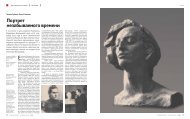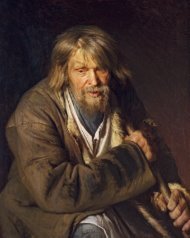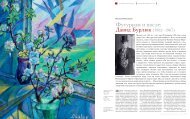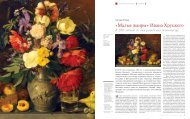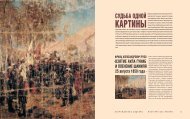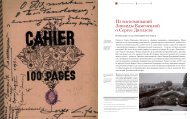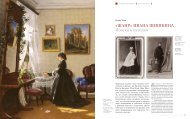Ðико ÐиÑоÑмани «Ðа бÑÐ´ÐµÑ Ð¿ÑоÑлавлена ÑÑа деÑниÑа» - ÐÑÑнал ...
Ðико ÐиÑоÑмани «Ðа бÑÐ´ÐµÑ Ð¿ÑоÑлавлена ÑÑа деÑниÑа» - ÐÑÑнал ...
Ðико ÐиÑоÑмани «Ðа бÑÐ´ÐµÑ Ð¿ÑоÑлавлена ÑÑа деÑниÑа» - ÐÑÑнал ...
You also want an ePaper? Increase the reach of your titles
YUMPU automatically turns print PDFs into web optimized ePapers that Google loves.
THE TRETYAKOV GALLERY<br />
HERITAGE<br />
HERITAGE<br />
Natalya Apchinskaya<br />
Niko Pirosmani<br />
“Glory to this right hand”<br />
Женщина<br />
с кружкой пива<br />
Клеенка, масло<br />
114 × 90<br />
Музей искусств Грузии,<br />
Тбилиси<br />
Woman with a Mug<br />
of Beer<br />
Oil on oilcloth<br />
114 × 90 cm<br />
Museum of Fine Arts,<br />
Tbilisi<br />
1 Khomeriki, M. New archival<br />
materials about Pirosmani<br />
and his family / Georgian<br />
University. No. 5(49).<br />
November, 2003.<br />
(In Georgian.)<br />
In December 2008 the Proun Gallery, at the Vinzavod Contemporary<br />
Art Centre, held a Pirosmani retrospective exhibition,<br />
the first show of the artistʼs work in Moscow for many years.<br />
Impeccably designed and staged, it featured 20 works by Pirosmani,<br />
mainly from private collections, along with supporting<br />
photographic and other visual materials. It proved a huge success<br />
with the public, which was ready to queue for some time<br />
to see it. This article is a tribute to the art of the outstanding<br />
Primitivist painter.<br />
Niko Pirosmani – a vagrant artist who<br />
made pictures and sign-boards for<br />
Tiflis (Tbilisi) taverns for trifling remuneration,<br />
died forgotten by all in a hospital for<br />
the poor in 1918, and was buried in an<br />
unknown location; however he has<br />
remained in art history as the greatest<br />
Georgian artist of the modern age. His<br />
biography, pieced together from scarce surviving<br />
documentary evidence, today continues<br />
to be the focus of academic research.<br />
Nikolai Aslanovich Pirosmanashvili<br />
was born to a peasant family probably<br />
around 1866 (as Georgian art scholars<br />
recently found out) in the village of<br />
Shulaveri 1 – not in the neighboring Mirzaani<br />
village as was previously assumed. His<br />
parents died soon after his birth, and the<br />
boy was raised by the Kalantarovs, a<br />
wealthy Armenian family in Tiflis. When<br />
Niko grew up and left his guardians’<br />
home, he tried to find his bearings in the<br />
practical world: together with a partner he<br />
set up a workshop making sign-boards. For<br />
several years he worked as a railway brakeman;<br />
he also kept a small store. But all his<br />
attempts to secure a steady income<br />
through a practical occupation failed. A<br />
loftier fate was in store for him.<br />
In the late 19th century he worked as a<br />
painter in taverns and other similar establishments<br />
in Tiflis, creating sign-boards, oil<br />
paintings, murals and glass paintings, which<br />
did not survive. The artist mostly worked in<br />
poor Tiflis neighborhoods on the left bank<br />
of the Kura River. Very soon he developed<br />
an individual style and contrived to use a<br />
material unheard-of among painters – high<br />
quality black oilcloth produced for industrial<br />
needs. Sometimes Pirosmani painted on<br />
pieces of cardboard, tin plates and, occasionally,<br />
canvas, although most often he<br />
used oilcloth, the durability and elasticity of<br />
which helped the pictures to survive in a relatively<br />
good condition.<br />
Some of the tavern keepers appreciated<br />
Pirosmani’s art, commissioning work<br />
from him. While closely tied with this<br />
milieu, the artist nevertheless seemed to<br />
inhabit a different world. People entangled<br />
in day-to-day difficulties thought of him as<br />
a man “not of this world”. The talent that<br />
scorched him inside, his loneliness, existence<br />
outside a daily routine, and his drinking<br />
habit that grew over the years – all this<br />
was sapping the life out of him. His demise<br />
was precipitated by social cataclysms.<br />
Returning to Tiflis from the provinces in<br />
early 1918, a sick Pirosmani found himself<br />
without friends and means of subsistence<br />
(most taverns were closed because of the<br />
turmoil). It is now believed that the artist<br />
died in a hospital on the eve of the Easter on<br />
May 4; he was buried on May 9 at the Kukiiskoe<br />
cemetery for unidentified bodies 2 .<br />
At the end of Georgy Shengelaya’s<br />
famous film “Pirosmani” the key character,<br />
defying worldly logic and in accordance<br />
with a more sublime logic of art, does not<br />
die; instead, to the accompaniment of the<br />
cheerful Easter peal of church bells, he<br />
moves, not to a hospital, but into the<br />
future…<br />
For Pirosmani that future began in the<br />
1910s, thanks to the enthusiastic support of<br />
Mikhail Le Dantyu (who was killed in the<br />
first World War), a talented artist and art<br />
theoretician close to Mikhail Larionov, and<br />
the Zdanevich brothers – Kirill, who studied<br />
with Le Dantyu at the St. Petersburg<br />
Academy of Fine Arts, and Ilya, who was<br />
then a law student and later became an<br />
avant-garde poet living in France and writing<br />
under the pen name “Iliazd”. Each of<br />
these people contributed to the efforts to<br />
preserve Pirosmani’s art for posterity and to<br />
secure for him a place in the history of<br />
world art 3 .<br />
Семейная<br />
компания. 1909<br />
Клеенка на холсте,<br />
масло. 116 × 170<br />
ГТГ<br />
A Family<br />
Get-together. 1909<br />
Oil, black oilcloth<br />
on canvas<br />
116 × 170 cm<br />
Tretyakov Gallery<br />
2 Op.cit.<br />
3 Strigalev, Anatoly. How<br />
Pirosmaniʼs art was discovered<br />
/ Pirosmani, Niko.<br />
Family feast: exhibition<br />
catalogue. Moscow, 2008.<br />
Pp. 17-41.<br />
As an artist Pirosmani was uniquely<br />
positioned between individualized style and<br />
traditional folk forms, between modern and<br />
ancient art. Unlike the great masters of past<br />
eras, who did not sign their works, he signed<br />
his, creating unconventional images<br />
inspired by reality, and valuing independence<br />
and creative freedom above all. It is<br />
known that when a merchant Meskhishvili<br />
offered the artist a permanent job, he<br />
proudly replied: “I don’t want to get shackled.”<br />
But for all his individualism, Pirosmani<br />
was deeply rooted in his native soil,<br />
which retained in its “cultural layer” a<br />
memory of ancient and medieval art.<br />
Unlike his contemporaries, professional<br />
painters who received an academic<br />
training, Pirosmani, in the formulation<br />
used in Shengelaya’s film, “did not know<br />
how to paint properly”. His art was generally<br />
intuitive, and it was due to this singular<br />
intuition that he could penetrate the existential<br />
depths impenetrable for artists who<br />
had a more rational mindset and were less<br />
gifted.<br />
Deeply religious, Pirosmani used to<br />
say about himself: “I was not an icon<br />
painter, I painted St. George only once.”<br />
Pirosmani believed that this saint, from<br />
whose name the country’s name, Georgia,<br />
was derived, was his personal patron, and<br />
depicted St. George, with an unmatched<br />
craftsmanship, in one of his oilcloth pictures.<br />
There is also another pronouncement<br />
that has survived: “I believe in my St.<br />
George. When I go to bed, he materializes<br />
with a whip in his hand by my bedstead and<br />
says, ‘Don’t be afraid!’ And in the morning<br />
my brush paints by itself.”<br />
But Pirosmani did not paint saints or<br />
religious subjects – he focused on his contemporaries,<br />
residents of Tiflis and the villages<br />
of Kakheti. Painted with wide, liberal<br />
strokes, the figures shine against a black<br />
background and, in spite of the down-toearth<br />
nature of the scenes represented in the<br />
pictures, embodied both real and surreal elements;<br />
the entire tenor of the imagery<br />
evoked Georgian medieval frescos and icons.<br />
Although Pirosmani spent almost all<br />
of his life in Tiflis, he did not become a poet<br />
of city life like France’s Henri Rousseau.<br />
His art is mostly focused on people and<br />
nature, as well as peasants’ life in the country.<br />
Most of Pirosmani’s surviving works are<br />
images of people and animals.<br />
Pictures of animals are an impressive<br />
part of the Georgian artist’s legacy, a special<br />
genre which is not so much “animalist” as<br />
“animist” (from “anima” – “soul”, not<br />
from “animal”). The images do not simply<br />
reproduce the exterior and manners of an<br />
animal; representing the animating element<br />
of nature rather than faithfully reproducing<br />
its physical appearance, they seem to live a<br />
life of their own.<br />
46 ТРЕТЬЯКОВСКАЯ ГАЛЕРЕЯ / THE TRETYAKOV GALLERY / #1’2009 ТРЕТЬЯКОВСКАЯ ГАЛЕРЕЯ / THE TRETYAKOV GALLERY / #1’2009 47



